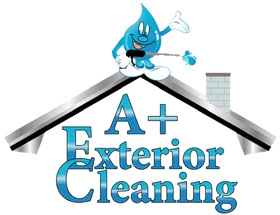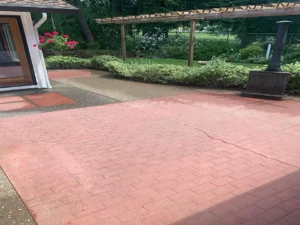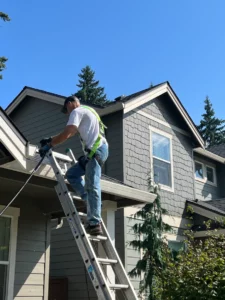The Environmental Impact of Roof Moss Removal: What You Should Know
When you notice green, velvety patches creeping across your roof, your first instinct is likely to get rid of them. Roof moss can be an eyesore and, in some cases, a threat to your home’s structural integrity. But have you ever stopped to consider the environmental consequences of how you remove it? The methods and products used can have a significant, often overlooked, impact on the world just outside your door.
Many homeowners reach for the quickest solution, like a powerful chemical spray or a high-pressure washer, without fully understanding the ripple effects. These methods can introduce harmful substances into our waterways, disrupt delicate local ecosystems, and consume excessive amounts of precious resources. Making an informed decision about roof moss removal is about more than just maintaining your roof; it’s about being a responsible steward of the environment.
Understanding Roof Moss: Friend or Foe?
Before we discuss removal, it’s important to understand what moss is and why it grows on your roof. Mosses are small, non-vascular plants that thrive in damp, shady environments. They don’t have true roots; instead, they use tiny hair-like structures called rhizoids to anchor themselves to surfaces like roof shingles. They absorb water and nutrients directly through their leaves.
The Good Side of Moss
In a forest, moss plays a vital role. It helps retain moisture in the soil, provides a habitat for tiny insects and microorganisms, and prevents soil erosion. On a small scale, it can even contribute to air purification by absorbing pollutants. Its lush, green appearance can also add a certain rustic charm to old stone walls and garden paths.

The Potential Harm to Your Roof
The story changes when moss takes up residence on your roof. Because mosses absorb and hold a significant amount of water, they can cause serious problems for your home:
- Water Damage: The constant moisture held by moss can seep underneath your shingles, leading to rot in the underlying roof decking and potentially causing leaks inside your home.
- Structural Damage: In colder climates, the water trapped by moss can freeze and expand. This process, known as frost-heaving, can lift and crack shingles, compromising their integrity and shortening the lifespan of your roof.
- Gutter Blockages: As moss grows, clumps can break off and wash into your gutters, causing blockages. This prevents proper water drainage and can lead to water overflowing and damaging your foundation or siding.
- Pest Infestations: The damp, sheltered environment created by thick moss mats is an attractive home for insects, spiders, and other pests.
While moss itself isn’t inherently “bad,” its presence on a roof can lead to costly and significant damage over time. Therefore, managing and removing it becomes a necessary part of home maintenance.
Common Moss Removal Methods
There are three primary methods for removing moss from a roof: power washing, chemical treatments, and manual removal. Each comes with its own set of procedures, costs, and, most importantly, environmental impacts.
Power Washing (or Pressure Washing)
Power washing uses a high-pressure stream of water to blast moss, algae, and grime off the roof surface. It’s fast and delivers immediate, visible results, which makes it a popular choice for many homeowners seeking a quick fix. However, this speed and force come at a significant cost to both your roof and the environment.
Chemical Treatments
This method involves applying chemical solutions, often containing zinc sulfate, potassium salts, or bleach-based compounds, to the roof. These chemicals are formulated to kill the moss, causing it to dry up and detach, after which it can be brushed or rinsed away. While effective at killing the growth, these chemicals don’t just disappear into thin air.
Manual Removal
Manual removal is the most labor-intensive method. It involves using hand tools, such as a stiff-bristled brush, to physically scrub and scrape the moss off the roof shingles. This technique is often followed by a low-pressure rinse to wash away the dislodged debris. It requires more effort but is generally considered the most gentle approach for both the roof and the surrounding environment.
The Environmental Impact of Power Washing
Using a high-pressure washer might seem like an eco-friendly choice since it primarily uses water. However, the reality is far more complex and damaging.
- Excessive Water Consumption: Power washers use a tremendous amount of water, typically between 2 to 8 gallons per minute. A standard roof cleaning can consume hundreds, if not thousands, of gallons of water, placing a strain on local water resources, especially in areas prone to drought.
- Harmful Runoff: The high-pressure water stream doesn’t just remove moss; it also dislodges granules from asphalt shingles, particles of roofing material, and any other pollutants that have settled on your roof. This contaminated slurry washes directly into storm drains, which often lead straight to local rivers, lakes, and streams without any filtration.
- Habitat Disruption: The forceful blast of water can disturb or destroy the micro-habitats of beneficial insects and microorganisms living on and around your roof. It can also damage nearby vegetation, stripping leaves from plants and eroding the soil in your garden beds.
Furthermore, power washing can severely damage the roof itself by stripping away the protective granular surface of asphalt shingles, voiding manufacturer warranties and drastically shortening the roof’s lifespan. This leads to premature roof replacement, generating significant landfill waste.
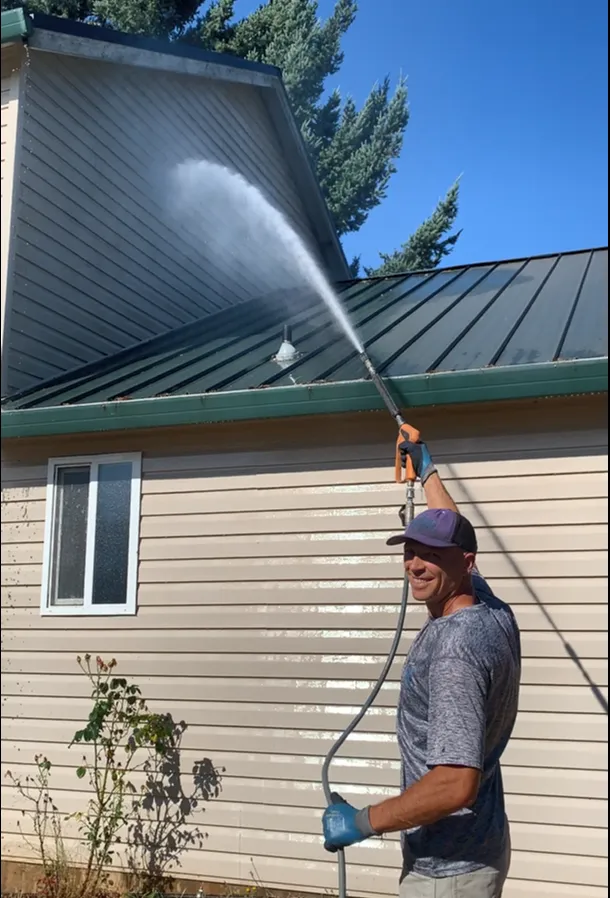
Chemical Treatments and Their Consequences
Applying chemicals may seem less abrasive than power washing, but their invisible impact can be far more insidious, affecting plant life, water systems, and wildlife.
- Toxicity to Plant Life: Many moss-killing chemicals are non-selective, meaning they harm or kill any plant they touch. Runoff from a chemically treated roof can flow directly into your garden beds, killing flowers, shrubs, and even damaging the root systems of mature trees. The residue can also render the soil toxic for future planting.
- Water System Contamination: Chemicals like zinc sulfate and bleach are toxic to aquatic life. When these substances wash into storm drains and enter local water systems, they can kill fish, frogs, and essential aquatic insects that form the base of the food web. This disrupts the delicate balance of the entire aquatic ecosystem.
- Risk to Pets and Wildlife: The chemical residue left on the roof and the ground below can be hazardous to pets, birds, and other wildlife. Animals that walk across a treated area may absorb toxins through their paws, and those that drink from contaminated puddles can become seriously ill.
While some “eco-friendly cleaning” chemical options are available, it’s crucial to scrutinize their ingredients and understand that even biodegradable products can cause harm before they break down.
Manual Moss Removal: A Greener Alternative?
At first glance, manual removal seems like the most environmentally sound option. It uses no harsh chemicals and minimal water. By physically scrubbing the moss away, you avoid introducing toxins into the environment and prevent the damage associated with high-pressure washing.
Pros of Manual Removal
- No Chemical Runoff: This is the most significant environmental advantage. You completely eliminate the risk of contaminating soil and water systems.
- Water Conservation: Only a small amount of water is needed for a final, low-pressure rinse, making it a water-wise choice.
- Roof Protection: When done correctly with the right tools, manual scraping is far gentler on shingles than power washing, helping to preserve the life of your roof.
Cons and Best Practices
However, manual removal is not without its challenges. It is physically demanding, time-consuming, and can be dangerous if proper safety precautions aren’t taken. Improper technique, such as using a metal brush or scraping too aggressively, can still damage shingles.
For these reasons, while manual removal is a greener path, it’s often best left to professionals who have the right equipment, training, and safety protocols to do the job effectively and without risk.
The A+ Exterior Cleaning Eco-Friendly Approach
At A+ Exterior Cleaning, we believe that effective roof moss removal and environmental responsibility go hand in hand. We have developed a specialized approach that prioritizes the health of your roof and the surrounding ecosystem.
Our method, known as “soft washing,” combines the best elements of manual and chemical treatments while mitigating their drawbacks.
- Gentle Application of Eco-Friendly Solutions: We use a custom-blended, biodegradable cleaning solution that is specifically formulated to kill moss, algae, and lichen. This solution is applied with a very low-pressure system—no stronger than a garden hose—which ensures no damage to your roof shingles.
- Targeted and Controlled Process: Our trained technicians carefully apply the solution only where it’s needed, minimizing overspray. We also take proactive steps to protect your landscaping by pre-wetting plants and covering delicate vegetation.
- Natural Decomposition: The solution works over time to kill the moss at its root. The dead moss then naturally weathers away with rain and wind, eliminating the need for aggressive scrubbing or high-pressure rinsing that can damage your roof. This process mimics nature’s own cleaning cycle.
- Long-Term Prevention: Our treatment not only removes existing growth but also inhibits future moss development, keeping your roof cleaner for longer. This reduces the frequency of treatments needed, further minimizing environmental impact.
This thoughtful and professional process ensures a beautiful, moss-free roof without compromising the health of your property or the local environment.
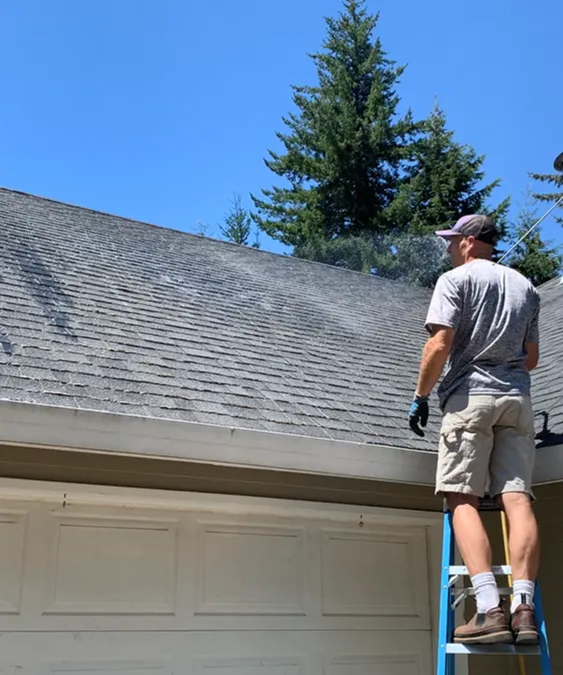
How to Choose an Environmentally Conscious Path
Whether you decide to tackle the job yourself or hire a professional for roof removal, you have the power to make an eco-friendly choice.
- Ask Questions: If hiring a company, ask them about their specific methods. What chemicals do they use? Are they biodegradable? What measures do they take to protect your plants and prevent runoff? A reputable, eco-conscious company like A+ Exterior Cleaning will be transparent about its process.
- Avoid High Pressure: Never let anyone use a high-pressure washer on your asphalt shingle roof. The risk of damage and environmental harm is simply too high.
- Consider the Source: If opting for a DIY chemical treatment, read the labels carefully. Research the active ingredients and their known environmental impacts before purchasing.
- Prioritize Prevention: The best way to manage moss is to prevent it from growing in the first place. Trim overhanging tree branches to allow more sunlight to reach your roof, and keep your gutters clean to ensure proper drainage.
A Cleaner Roof, A Greener Planet
Your roof is your home’s first line of defense against the elements, and maintaining it is essential. But the choices we make in that maintenance have consequences that extend beyond our property lines. By moving away from harsh, outdated methods like power washing and indiscriminate chemical use, we can protect our investment and our shared environment.
Choosing a responsible, professional service that utilizes modern, eco-friendly techniques is the most effective way to ensure a clean roof and a clear conscience. Make the informed choice to protect your home, your family, and the natural world around you.
https://www.google.com/maps?cid=9581861370272832557
